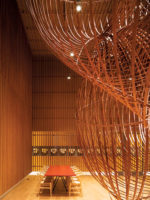Chicago
If it were only a case of “practice what you preach,” the sustainably designed Midwest offices of the Natural Resources Defense Council (NRDC) would offer an impressive enough example, with a new space that exploits daylight and incorporates reclaimed materials. But this esteemed environmental-action group and its architect, Studio Gang, wanted to set a new standard. The project surpasses LEED Platinum to become the world's first tenant retrofit to achieve certification through the Living Building Challenge, the built environment's most rigorous performance standard. More than that, though, the office is a stunning workplace, with a carefully considered layout that caters to the unique needs of the Chicago branch of the organization's small but growing staff of lawyers, economists, engineers, communications specialists, and policy experts.
“When we asked ourselves, 'What kind of measure do we want to use?' ” explains Studio Gang principal Jeanne Gang, “we realized that by taking on the Living Building Challenge, we essentially joined the movement to require transparency in the content of building materials. That has the potential to transform the industry faster.”
The 7,800-square-foot office occupies the 16th floor of the entire northern wing of the 1929 Civic Opera House Building in The Loop. “We wanted to address the already-built environment and show that we could renovate an old structure to meet our own mission goals,” says NRDC Midwest director Henry Henderson. “We also liked the space and its position on the river.” Its deep footprint was a factor in the decision to forgo private offices for an open plan that would bring sunlight and ventilation to all workstations, strategically located along the perimeter. Daylight-responsive sensors control lighting within 15 feet of the perimeter glazing and over 50 percent of the total lighting load. LED task lamps supplement illumination at cubicles. Such measures contributed to the project's impressive Lighting Power Density calculation, which shows a 40.02% reduction compared to an ASHRAE 90.1-2007 baseline.
Dedicated areas for both collaborative and focused independent work surround the staircase and elevator core. An irregular configuration of glazed meeting rooms, kitchen, flex areas, and support spaces cheekily takes the shape of the state of Illinois in plan (oriented east'west). Large, more private conference rooms cap the eastern edge of the office. Occupancy sensors regulate the locally sourced pendant lights that serve as focal points in many of these areas.
To unify the open areas, the architect reprised and refined a rope structure it first experimented with for an exhibition of the firm's work at the Art Institute of Chicago last year. For this project, a more intricate version of the installation became the perfect framework on which easy-to-maintain plants could flourish, aided by overhead grow lights.
With scant material, the rope latticework provides a striking three-dimensional surface that conceals structural columns among the shoulder-high workstations and graces a wall of the reception area. A second wall composed of reclaimed door moldings also greets visitors there.
The d'cor is playful and straightforward. Refurbished vintage mid-20th-century pieces comprise many of the furnishings in the space. Staggered two- and four-foot fluorescent tubes intermingle with cutouts in the acoustical ceiling to lessen the sense of directionality of the lighting'an arrangement that also offers flexibility for future ceiling modification. The finishes and all light fixtures were approved by the Living Building Institute.
Meeting the Living Building Challenge naturally lent itself to the “back to basics” design approach the architect took. Remarkably, it also satisfied the client's limited budget and constricted timeline for the project. According to Gang, “Truly engaging the users and setting goals at the beginning of a project are key parts to its ultimate success.”
Trained as an architect, Josephine Minutillo is a New York'based writer for RECORD.
Size: 7,800 square feet
Cost: withheld
Completion date: July 2013
Architect:
Studio Gang Architects ' Jeanne Gang, design principal; Mark Schendel, managing principal; Margaret Cavenaugh, director of interiors; Angela Peckham, project manager
PeopleLocation: Completion Date: Gross square footage: Client: Owner: Architect: Personnel in architect's firm who should receive special credit: Mark Schendel, FAIA Margaret Cavenagh, AIA Angela Peckham Architect of record: Interior designer: Engineers: Consultant(s): Owner/Client Representative: Closed Loop Advisors General contractor: Photographer: |
ProductsDoors Wood doors: Custom Manufactured wood frame glazing system by United Wood Working, Inc. Hardware Closers: Exit devices: Alkco/Phillips Signage Pulls: Rockwood Mfg. Interior finishes Suspension grid: U.S. Gypsum Cabinetwork and custom woodwork: Custom Manufactured by American Custom Woodworking, Inc. Paints and stains: Benjamin Moore (chalkboard paint, 'Natura' WG Eggshell and 'Eco-Spec' WB Eggshell) Paneling: See 'Special Interior Finishes' Solid surfacing: Reclaimed Granite Countertop & Backsplash by Bourbon Tile & Marble Floor and wall tile: Rubber EPDM by EcoSurface ('EcoNights for ESD') in server rooms Resilient flooring: Aquaria Floor Finish by Diversey, Inc on Levelrock ('Ultra Armor') by U.S. Gypsum Carpet: 'The Brights' carpet tile collection by Bolyu Special interior finishes unique to this project: Window covering: Furnishings Office furniture: Systems Furniture by Knoll Reception furniture: Custom reclaimed barn wood reception desk by United Woodworking Chairs: Tables: Upholstery: Lighting Downlights: Task lighting: Dimming System or other lighting controls: Lutron Sustainability: Plumbing Energy Other unique products that contribute to sustainability: Energy
Water Community Materials Indoor Environmental Quality Add any additional building components or special equipment that made a significant contribution to this project: |






